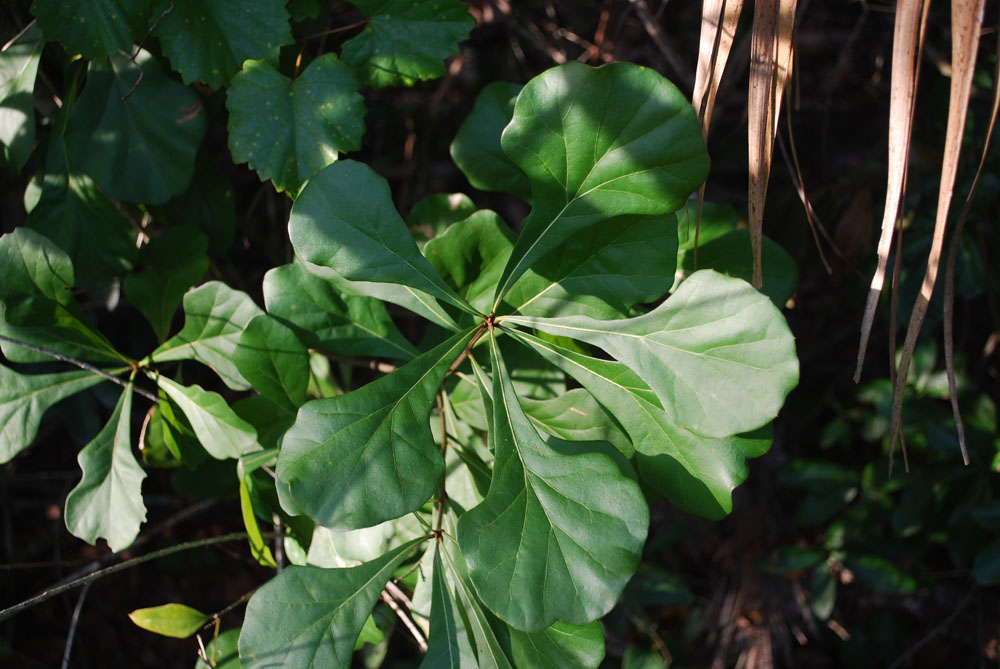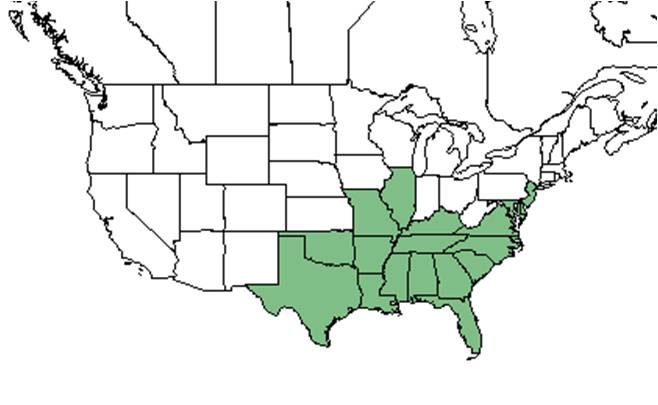Difference between revisions of "Quercus nigra"
| Line 31: | Line 31: | ||
==Ecology== | ==Ecology== | ||
===Habitat===<!--Natural communities, human disturbed habitats, topography, hydrology, soils, light, fire regime requirements for removal of competition, etc.--> | ===Habitat===<!--Natural communities, human disturbed habitats, topography, hydrology, soils, light, fire regime requirements for removal of competition, etc.--> | ||
| + | ''Q. nigra'' has been found in stream shorelines, hardwood sand ridges, upland woodlands, floodplains, lake shores, river shores, pine-oak woodlands, longleaf pine-wiregrass ridges, cypress swamps, oak ravines, and live oak hammocks.<ref name="FSU"/> It is also found in disturbed areas including sandhills with mowed lawns, sandy roadsides, campgrounds, nature trails, and along bridges.<ref name="FSU"> Florida State University Herbarium Database. URL: http://herbarium.bio.fsu.edu. Last accessed: June 2021. Collectors: Loran C. Anderson, Robert Doren, Alan R. Franck, Robert K. Godfrey, Bruce Hansen, JoAnn Hansen, H. Kurz, Herbert Monoson, Gwynn W. Ramsey, Ann M. Redmond, W. D. Reese, H. Larry Stripling, and Dwayne Wise. States and counties: Florida: Clay, Columbia, Franklin, Gadsden, Hillsborough, Jackson, Leon, Madison, St. Johns, and Wakulla.</ref> Associated species: ''Nyssa, Ulmus'', and ''Taxodium''.<ref name="FSU"/> | ||
| + | |||
''Q. nigra'' responds positively to soil disturbance by heavy silvilculture in North Carolina.<ref>Cohen, S., R. Braham, and F. Sanchez. (2004). Seed Bank Viability in Disturbed Longleaf Pine Sites. Restoration Ecology 12(4):503-515.</ref> However, it responds negatively to soil disturbance by clearcutting and chopping in North Florida flatwoods forests.<ref>Moore, W.H., B.F. Swindel, and W.S. Terry. (1982). Vegetative Response to Clearcutting and Chopping in a North Florida Flatwoods Forest. Journal of Range Management 35(2):214-218.</ref> | ''Q. nigra'' responds positively to soil disturbance by heavy silvilculture in North Carolina.<ref>Cohen, S., R. Braham, and F. Sanchez. (2004). Seed Bank Viability in Disturbed Longleaf Pine Sites. Restoration Ecology 12(4):503-515.</ref> However, it responds negatively to soil disturbance by clearcutting and chopping in North Florida flatwoods forests.<ref>Moore, W.H., B.F. Swindel, and W.S. Terry. (1982). Vegetative Response to Clearcutting and Chopping in a North Florida Flatwoods Forest. Journal of Range Management 35(2):214-218.</ref> | ||
Revision as of 13:58, 9 June 2021
| Quercus nigra | |
|---|---|

| |
| Photo by Wayne Matchett, SpaceCoastWildflowers.com | |
| Scientific classification | |
| Kingdom: | Plantae |
| Division: | Magnoliophyta - Flowering plants |
| Class: | Magnoliopsida – Dicotyledons |
| Order: | Fagales |
| Family: | Fagaceae |
| Genus: | Quercus |
| Species: | Q. nigra |
| Binomial name | |
| Quercus nigra L. | |

| |
| Natural range of Quercus nigra from USDA NRCS Plants Database. | |
Common name: Water oak
Contents
Taxonomic notes
Synonyms: Q. aquatica Walter
Varieties: Quercus nigra var. heterophylla (Aiton) W.W. Ashe; Q. nigra var. nigra
Description
A description of Quercus nigra is provided in The Flora of North America.
Distribution
Ecology
Habitat
Q. nigra has been found in stream shorelines, hardwood sand ridges, upland woodlands, floodplains, lake shores, river shores, pine-oak woodlands, longleaf pine-wiregrass ridges, cypress swamps, oak ravines, and live oak hammocks.[1] It is also found in disturbed areas including sandhills with mowed lawns, sandy roadsides, campgrounds, nature trails, and along bridges.[1] Associated species: Nyssa, Ulmus, and Taxodium.[1]
Q. nigra responds positively to soil disturbance by heavy silvilculture in North Carolina.[2] However, it responds negatively to soil disturbance by clearcutting and chopping in North Florida flatwoods forests.[3]
Quercus nigra is frequent and abundant in the North Florida Longleaf Woodlands, Xeric Flatwoods, and North Florida Wet Flatlands community types as described in Carr et al. (2010).[4]
Phenology
Q. nigra has been observed flowering in February and March.[5]
Seed dispersal
This species is thought to be dispersed by gravity. [6]
Pollination
The following Hymenoptera families and species were observed visiting flowers of Quercus nigra at Archbold Biological Station:[7]
Apidae: Apis mellifera
Conservation, cultivation, and restoration
Cultural use
Photo Gallery
References and notes
- ↑ 1.0 1.1 1.2 Florida State University Herbarium Database. URL: http://herbarium.bio.fsu.edu. Last accessed: June 2021. Collectors: Loran C. Anderson, Robert Doren, Alan R. Franck, Robert K. Godfrey, Bruce Hansen, JoAnn Hansen, H. Kurz, Herbert Monoson, Gwynn W. Ramsey, Ann M. Redmond, W. D. Reese, H. Larry Stripling, and Dwayne Wise. States and counties: Florida: Clay, Columbia, Franklin, Gadsden, Hillsborough, Jackson, Leon, Madison, St. Johns, and Wakulla.
- ↑ Cohen, S., R. Braham, and F. Sanchez. (2004). Seed Bank Viability in Disturbed Longleaf Pine Sites. Restoration Ecology 12(4):503-515.
- ↑ Moore, W.H., B.F. Swindel, and W.S. Terry. (1982). Vegetative Response to Clearcutting and Chopping in a North Florida Flatwoods Forest. Journal of Range Management 35(2):214-218.
- ↑ Carr, S.C., K.M. Robertson, and R.K. Peet. 2010. A vegetation classification of fire-dependent pinelands of Florida. Castanea 75:153-189.
- ↑ Nelson, G. PanFlora: Plant data for the eastern United States with emphasis on the Southeastern Coastal Plains, Florida, and the Florida Panhandle. www.gilnelson.com/PanFlora/ Accessed: 13 DEC 2016
- ↑ Kirkman, L. Katherine. Unpublished database of seed dispersal mode of plants found in Coastal Plain longleaf pine-grasslands of the Jones Ecological Research Center, Georgia.
- ↑ Deyrup, M.A. and N.D. 2015. Database of observations of Hymenoptera visitations to flowers of plants on Archbold Biological Station, Florida, USA.